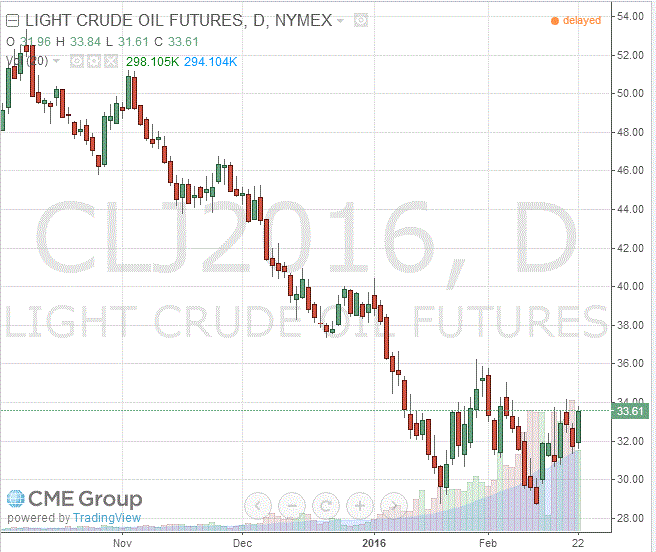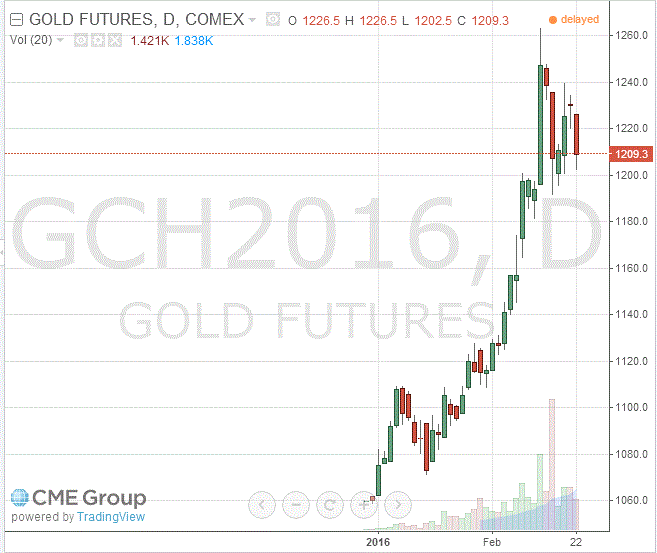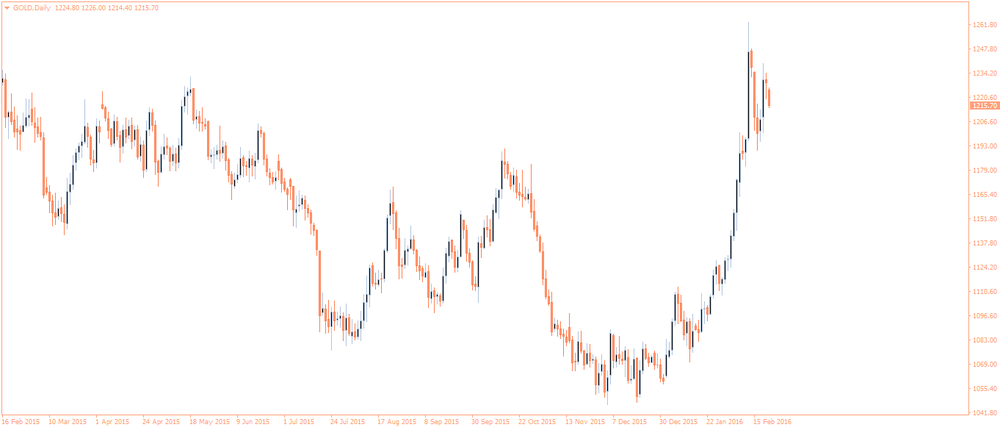Noticias del mercado
-
17:47
Oil prices rise around 2%
Oil prices rose on the IEA report and the Baker Hughes data. The oil driller Baker Hughes reported on Friday that the number of active U.S. rigs declined by 26 rigs to 413 last week. It was the lowest level since December 2009.
The International Energy Agency (IEA) released its Medium-Term Oil Market Report (MTOMR) on Monday. The agency said that the oil market will rebalance in 2017 as the U.S. oil output is expected to decline.
"Only in 2017 will we finally see oil supply and demand aligned but the enormous stocks being accumulated will act as a dampener on the pace of recovery in oil prices when the market, having balanced, then starts to draw down those stocks," the IEA noted.
WTI crude oil for April delivery increased to $33.61 a barrel on the New York Mercantile Exchange.
Brent crude oil for April rose to $34.86 a barrel on ICE Futures Europe.
-
17:31
Gold declines more than 1%
Gold price declined on increasing demand for risky assets and a stronger U.S. dollar. The greenback remained supported by Friday's U.S. consumer price inflation data. According to the U.S. Labor Department, the U.S. consumer price index increased to 1.4% year-on-year in January from 0.7% in December, exceeding expectations for a rise to 1.3%. It was the biggest increase since October 2014. The U.S. consumer price index excluding food and energy increased to 2.2% year-on-year in January from 2.1% in December, beating expectations for a 2.1% rise.
Market participants speculate that the Fed will not raise its interest rate in March. They are focussed on the incoming U.S. economic data. Markit Economics released its preliminary manufacturing purchasing managers' index (PMI) for the U.S. on Monday. The U.S. preliminary manufacturing purchasing managers' index (PMI) plunged to 51.0 in January from 52.4 in January, missing expectations for a decline to 52.3. It was the lowest level since October 2012.
March futures for gold on the COMEX today fell to 1209.30 dollars per ounce.
-
15:31
The International Energy Agency expects the oil market to rebalance in 2017
The International Energy Agency (IEA) released its Medium-Term Oil Market Report (MTOMR) on Monday. The agency said that the oil market will rebalance in 2017 as the U.S. oil output is expected to decline.
"Only in 2017 will we finally see oil supply and demand aligned but the enormous stocks being accumulated will act as a dampener on the pace of recovery in oil prices when the market, having balanced, then starts to draw down those stocks," the IEA noted.
The agency expect the U.S. oil output to fall by 600,000 barrels per day (bpd) this year and by 200,000 bpd next year, while the oil output is forecasted to reach 14.2 million bpd from 2015 to 2021.
Iran's oil production is expected to climb by 1 million bpd to 3.9 million bpd by 2021.
The global oil supply is expected to rise by 4 million bpd between 2015 and 2021, while global oil exploration and production capital expenditures (capex) are forecasted to drop 17% in 2016, after a 24% fall in 2015.
The IEA expects the global oil demand to increase at an average rate of 1.2 million bpd through 2021.
-
14:29
The number of active U.S. rigs falls by 26 rigs to 413 last week
The oil driller Baker Hughes reported on Friday that the number of active U.S. rigs declined by 26 rigs to 413 last week. It was the lowest level since December 2009.
Combined oil and gas rigs decreased by 27 to 514.
-
10:21
China’s finance ministry plans to cut transaction taxes for home buyers
China's finance ministry said on Friday that it plans to cut transaction taxes for second-time home buyers and some first home buyers to stimulate the property market. The transaction tax on second homes smaller than 90 square meters will be lowered to 1% from 3%, while tax for homes of more than 90 square meters will be cut to 2. The tax on first homes larger than 144 square meters will be cut to 1.5% from 3%.
-
07:30
Oil rose
West Texas Intermediate futures for March delivery, which expires today, rose to $32.40 (+2.05%), while Brent crude advanced to $33.52 (+1.54%) as market participants welcomed a decline in U.S. rig count; however persistent concerns over the global supply glut kept a lid on gains.
Data from the Baker Hughes Rig Count showed on Friday that active rigs declined by 27 across the U.S. last week. The figure now stands at 514 compared to 1,310 a year ago. Experts believe that fewer rigs will result in lower production levels in the U.S. and help to ease the supply glut in 2016. But global supplies are still ample.
Optimism regarding an output freeze deal faded as such producers as Iraq and Iran made no statements on joining the agreement.
-
07:06
Gold declined
A stronger dollar pushed gold down to $1,217.60 (-1.06%), but bullion stayed above the key $1,200 an ounce level as concerns over the global economy and stock markets persisted. Gold remains one of the biggest gainers of 2016 so far. It has gained about 15% since the start of the year.
Flows data suggest investors believe in gold. Holdings of SPDR Gold Trust, the largest gold-backed exchange-traded-fund, rose by 2.71% to 732.96 tonnes on Friday, marking the biggest single day increase since August 2011.
-
00:30
Commodities. Daily history for Feb 19’2016:
(raw materials / closing price /% change)
Oil 29.72 +0.27%
Gold 1,226.60 -0.34%
-


